
Perhaps it’s because of the screening of SOMM later this week (Thursday, August 22, click here for details) or the fact it’s 100 degrees outside and the chilly, central AC has been beckoning but recently I’ve been revisiting some of my most favorite food and wine flicks. I find these films not only entertaining, but also very inspiring, each for different reasons. If you are a fan of food and/or wine, these films are mandatory so get comfy, whip up a batch of Black Truffle Popcorn (recipe below) and get watching! In no particular order, here are my top five:

1.) Jiro Dreams of Sushi: This touching and insightful 2011 documentary follows 85-year-old Sushi Chef Jiro Ono on his quest for culinary perfection. Ono has dedicated 75 years of his life perfecting the art of sushi which has culminated in a three-star Michelin rating for his world-renowned Tokyo restaurant, Sukiyabashi Jiro. The film follows his daily routine at the restaurant, the heart and soul of Ono’s existence, which includes his 50 year old elder son, Yoshikazu who is expected to assume the business after Ono retires (which doesn’t look likely, even at 85) or upon his death. This film explores a life dedicated to perfecting one’s craft, stresses the importance of respecting our natural resources and explores the inner workings of the traditional Japanese family all viewed through a culinary lens.

2.) Julie & Julia: The film that started it all – well, for me anyway! I was so inspired by this film back in 2009 that I started my first blog Stephanie Savors the Moment in which I cooked my way through the Junior League of Boca Raton’s James Beard Award-winning cookbook, Savor the Moment. Nostalgic moment aside, this wonderful film follows the parallel lives of legendary Chef Julia Child, played by the inimitable Meryl Streep, and blogger Julie Powell, played by the delightful Amy Adams, who learns to cook by working her way through Child’s Mastering the Art of French Cooking, cooking all 524 recipes in 325 days while blogging about her experience. This film was written and directed by the fabulous Nora Ephron so there’s absolutely nothing not to love about it and it also has a wonderful soundtrack which I keep on regular rotation in my office – I find it very inspiring!

3.) Bottle Shock: This 2008 film is based on the legendary Judgement of Paris, the 1976 blind wine tasting competition which pitted the wines of France against those from California, a relative winemaking newcomer. The competition was the brainchild of Steven Spurrier (played by Alan Rickman), a floundering British wine shop owner living in Paris who decides to hold the competition in order to generate business and PR for his shop. The beloved Dennis Farina plays Maurice, seemingly one of Spurrier’s only friends and customers. Spurrier travels to California in search of wines to feature in the competition and runs into the ornery Jim Barrett (played by Bill Pullman) of Chateau Montelena. Barrett is wholeheartedly against entering his wines in the competition, suspecting Spurrier’s main goal is to humiliate California vintners; however, his son Bo Barrett, played by Chris Pine, is determined to find a way to get the wines to France without his father knowing.

4.) A Good Year: This 2006 romantic comedy based on the Peter Mayle novel of the same name stars Russell Crowe (yes, you heard me, ladies!) as Max Skinner, a cocky, arrogant British banker who inherits a French Chateau and vineyard from his estranged Uncle Henry (played by Albert Finney) who has recently passed away. Upon the news of his inheritance, Max travels to Provence to see the property with the express intention of selling it. As you might expect, flashbacks of his childhood and time spent with Uncle Henry at the Chateau overcome him and, let’s just say he ends up spending more time than he originally expected. Filmed mostly in Luberon, which is very close to Provence, the scenery in this film is completely enchanting not to mention Crowe’s love interest, Fanny, played by the stunningly gorgeous Marion Cotillard. This movie is a veritable feast for the eyes and ears, featuring a truly fantastic soundtrack as well!

5.) Sideways: This 2004 Merlot-maligning film based on the Rex Pickett novel of the same name follows melancholy Miles Raymond (played by Paul Giamatti), a middle-aged, struggling author with a passion for wine, as he accompanies his philandering best friend Jack (played by Thomas Haden Church), on a wine soaked weekend in Santa Barbara County wine country. On the surface Miles is a very unlikable character who steals money from his own mother, constantly obsesses about his ex-wife and is prone to bouts of extreme wine snobbery (“I am NOT drinking any fucking Merlot!”) yet you somehow can’t help but like him. Alot of the movie was filmed at actual wineries including Foxen Winery, Firestone Winery, and Fess Parker Winery & Vineyard to name just a few. Throughout their journey Miles and Jack get into all kinds of hilarious trouble and leading ladies Virginia Madsen, who plays Maya, and Sandra Oh, who plays Stephanie, lend lots of interest and depth to the storyline.
No matter which movie you choose, I find Black Truffle Popcorn pairs well with just about everything! I could seriously eat an entire bowl of the stuff myself. To make it, I highly recommend using microwave Black Jewell Gourmet Popcorn, the shiny black kernels become a beautiful snow white color when popped and there’s alot less hull than yellow popcorn. Once popped, just add melted butter to taste, toss, and liberally sprinkle the popcorn with Black Truffle Salt which is usually available at your local gourmet market. If you happen to live near Boca Raton, you can find it at The Spice & Tea Exchange at Mizner Park. In addition to the film this popcorn also pairs remarkably well with a glass of bubbly – just sayin’.
I hope to see you at our screening of SOMM on Thursday at The Museum of Art Fort Lauderdale. For more information on the event, please click here. Also, I’d love to know what your favorite food and wine films are – do tell!
Cheers,
![]()
We're very excited about our special installment of The Art of Wine & Food taking place next Thursday, August 22nd! This month's event will feature a screening of the film SOMM which provides a humorous, emotional and illuminating look into the mysterious world of The Court of Master Sommeliers.In the film, four men will do anything to pass the most difficult test you’ve NEVER heard of: the daunting Master Sommelier Exam. The Court of Master Sommeliers is one of the world’s most prestigious, secretive, and exclusive organizations. Since its inception almost 40 years ago, less than 200 candidates have reached the exalted Master level. The exam covers literally every nuance of the world of wine, spirits and cigars.Those who have passed have put at risk their personal lives, their well- being, and often their sanity to pull it off. Shrouded in secrecy, access to the Court Of Master Sommeliers has always been strictly regulated and cameras have never been allowed anywhere near the exam, until now.How much do you think you know about wine? SOMM will make you think again.Following the film guests will enjoy a wine and food tasting featuring the delicious cuisine of Hugh's Catering and fabulous wines from our wine sponsor, Southern Wine and Spirits. As if that wasn't enough, we'll also have two very special guests on hand for a Q&A session, Master Sommelier, Brian Koziol and Master Sommelier Candidate, Sandra Wauquier. Bring your best wine questions for them!Cost for this special event is $50 per person which includes the film & wine tasting. Reservations are required and seating is limited. To RSVP, click here, or contact Gail Vilone at 954-262-0249. Hope to see you there!Cheers,

We’re very excited about our special installment of The Art of Wine & Food taking place next Thursday, August 22nd! This month’s event will feature a screening of the film SOMM which provides a humorous, emotional and illuminating look into the mysterious world of The Court of Master Sommeliers.
In the film, four men will do anything to pass the most difficult test you’ve NEVER heard of: the daunting Master Sommelier Exam. The Court of Master Sommeliers is one of the world’s most prestigious, secretive, and exclusive organizations. Since its inception almost 40 years ago, less than 200 candidates have reached the exalted Master level. The exam covers literally every nuance of the world of wine, spirits and cigars.
Those who have passed have put at risk their personal lives, their well- being, and often their sanity to pull it off. Shrouded in secrecy, access to the Court Of Master Sommeliers has always been strictly regulated and cameras have never been allowed anywhere near the exam, until now.
How much do you think you know about wine? SOMM will make you think again.
Following the film guests will enjoy a wine and food tasting featuring the delicious cuisine of Hugh’s Catering and fabulous wines from our wine sponsor, Southern Wine and Spirits. As if that wasn’t enough, we’ll also have two very special guests on hand for a Q&A session, Master Sommelier, Brian Koziol and Master Sommelier Candidate, Sandra Wauquier. Bring your best wine questions for them!
Cost for this special event is $50 per person which includes the film & wine tasting. Reservations are required and seating is limited. To RSVP, click here, or contact Gail Vilone at 954-262-0249. Hope to see you there!
Cheers,
![]()
With temperatures soaring into the high 90's and above this Summer in South Florida, I've been craving dishes with delicious, lighter flavors as well as the delightful wines that pair with them.The latest edition of "Fast & Fabulous" features Roasted Shrimp, Watercress and Farro Salad which definitely fits the bill. This dish has plenty of delicious flavor, great texture and healthy ingredients to boot. The recipe calls for farro, one of my favorite "ancient grains," that Italians have been eating for over 2,000 years!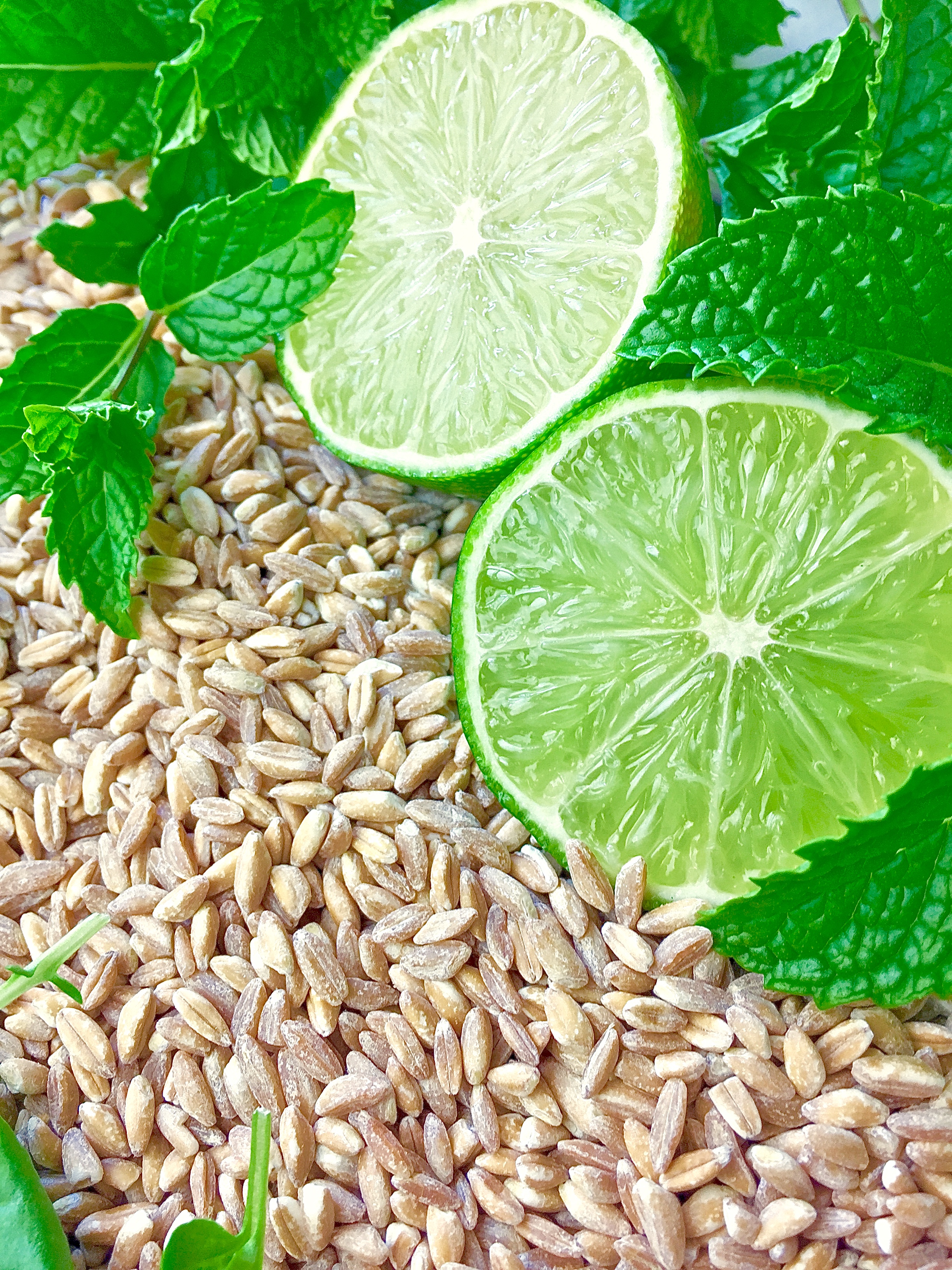
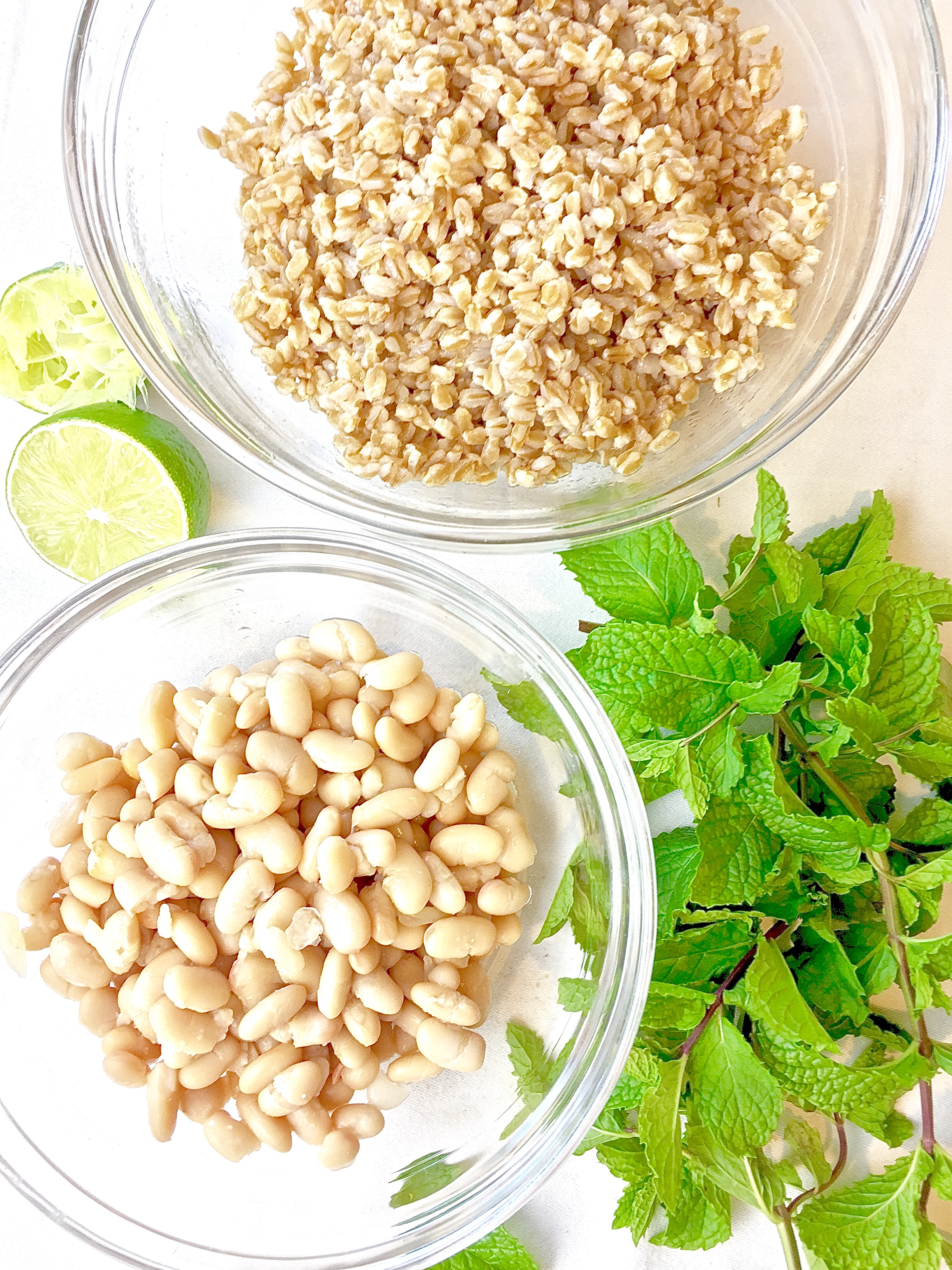 This grain is also known as emmer or hulled wheat and was widely cultivated in the ancient world giving rise to the term "ancient grains" that today is used to refer to farro and other grains such as quinoa, amaranth and spelt, all of which have enjoyed a surge in popularity in recent years.In addition to being tasty, farro also has health benefits including cholesterol-lowering fiber. A cup of farro has about 8 grams of fiber, while brown rice weighs in at around 5 grams. Whole grains like farro are also chock full of minerals such as magnesium which can help relieve tension and reduce the effects of stress. It's complex carbohydrates also break down slowly, helping to keep your energy and blood sugar levels stable.
This grain is also known as emmer or hulled wheat and was widely cultivated in the ancient world giving rise to the term "ancient grains" that today is used to refer to farro and other grains such as quinoa, amaranth and spelt, all of which have enjoyed a surge in popularity in recent years.In addition to being tasty, farro also has health benefits including cholesterol-lowering fiber. A cup of farro has about 8 grams of fiber, while brown rice weighs in at around 5 grams. Whole grains like farro are also chock full of minerals such as magnesium which can help relieve tension and reduce the effects of stress. It's complex carbohydrates also break down slowly, helping to keep your energy and blood sugar levels stable.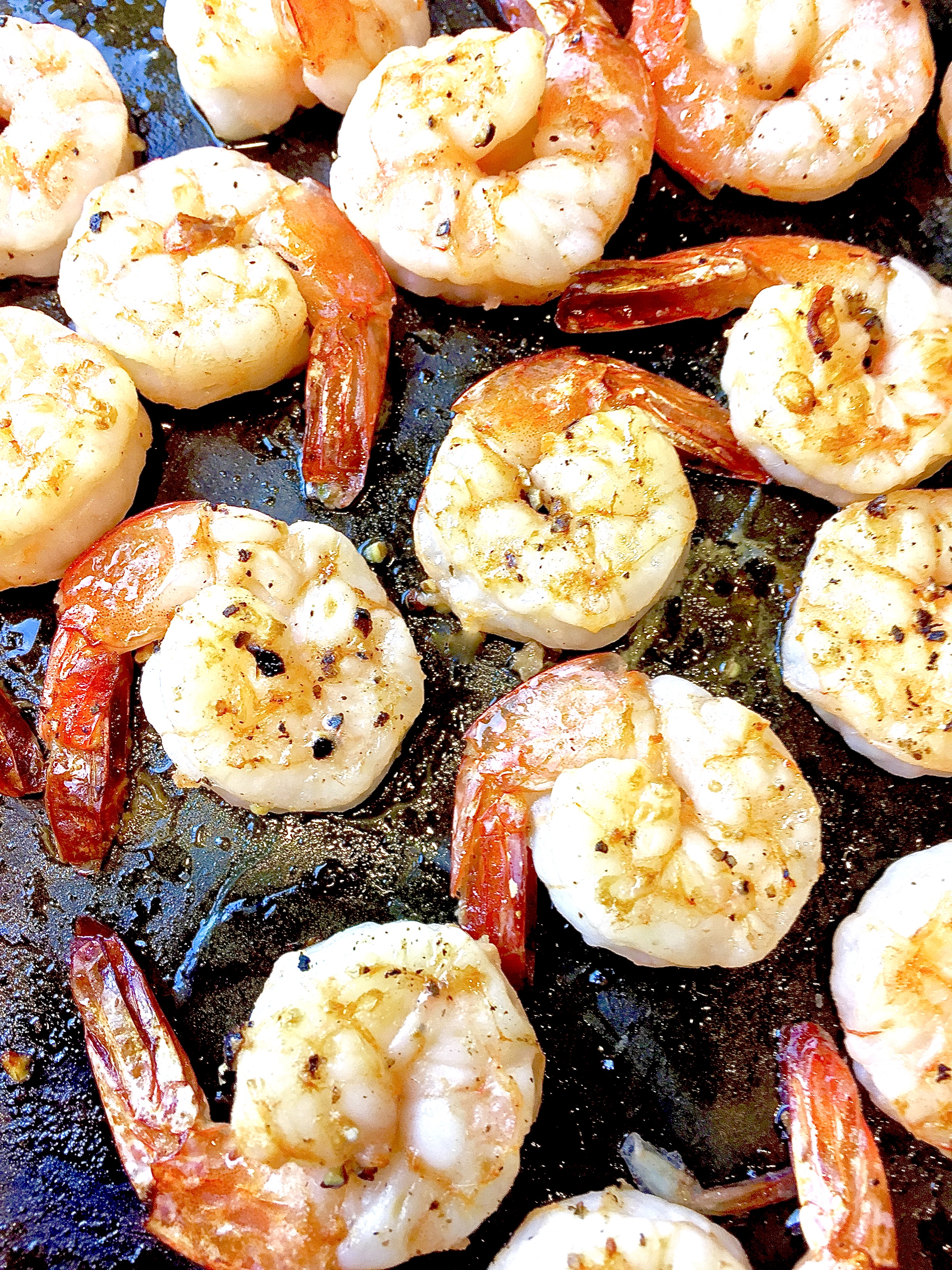 And what's more delicious than roasted shrimp? Seasoned liberally with salt, pepper and a generous squeeze of lime juice, the roasted shrimp lends amazing flavor to the dish. I like to use peeled and deveined jumbo size shrimp with the tails on since I think they make a nice presentation. Needless to say, "tails off" shrimp will work just fine too.Given this dish's Italian origins, I like to pair it with an Italian sparkler like the Vigne Regali Cuvée Aurora Rosé ($29). This bubbly hails from Italy's famed Piedmont region and is made from 100% Pinot Noir grapes from hilltop vineyards in the Langhe, south of Alba. This cuvée consists of 90% clear wine and 10% of the previous vintage wine, aged in French oak barriques. It is made using the Methode Traditionnelle, the same method used to make Champagne.
And what's more delicious than roasted shrimp? Seasoned liberally with salt, pepper and a generous squeeze of lime juice, the roasted shrimp lends amazing flavor to the dish. I like to use peeled and deveined jumbo size shrimp with the tails on since I think they make a nice presentation. Needless to say, "tails off" shrimp will work just fine too.Given this dish's Italian origins, I like to pair it with an Italian sparkler like the Vigne Regali Cuvée Aurora Rosé ($29). This bubbly hails from Italy's famed Piedmont region and is made from 100% Pinot Noir grapes from hilltop vineyards in the Langhe, south of Alba. This cuvée consists of 90% clear wine and 10% of the previous vintage wine, aged in French oak barriques. It is made using the Methode Traditionnelle, the same method used to make Champagne.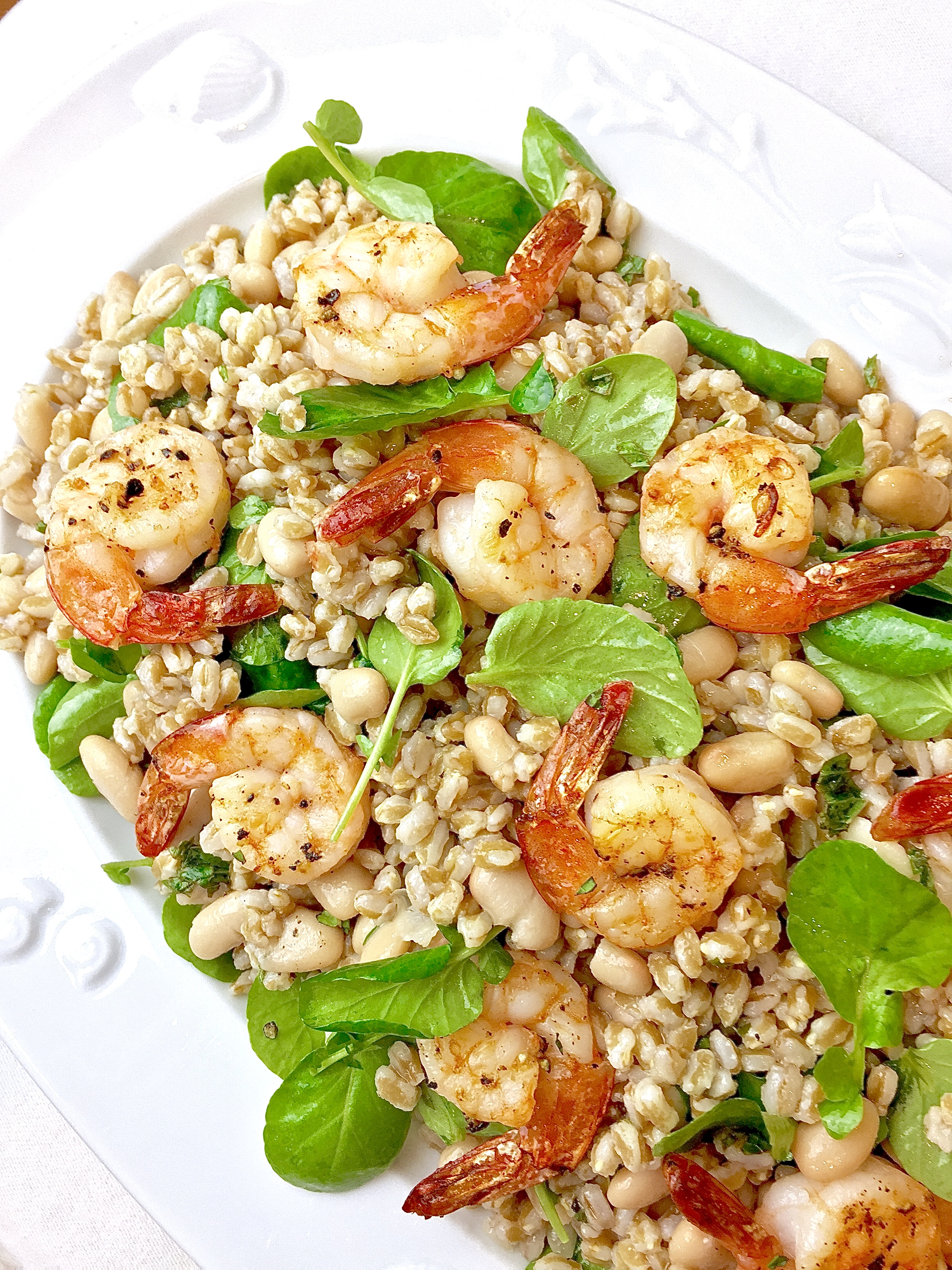
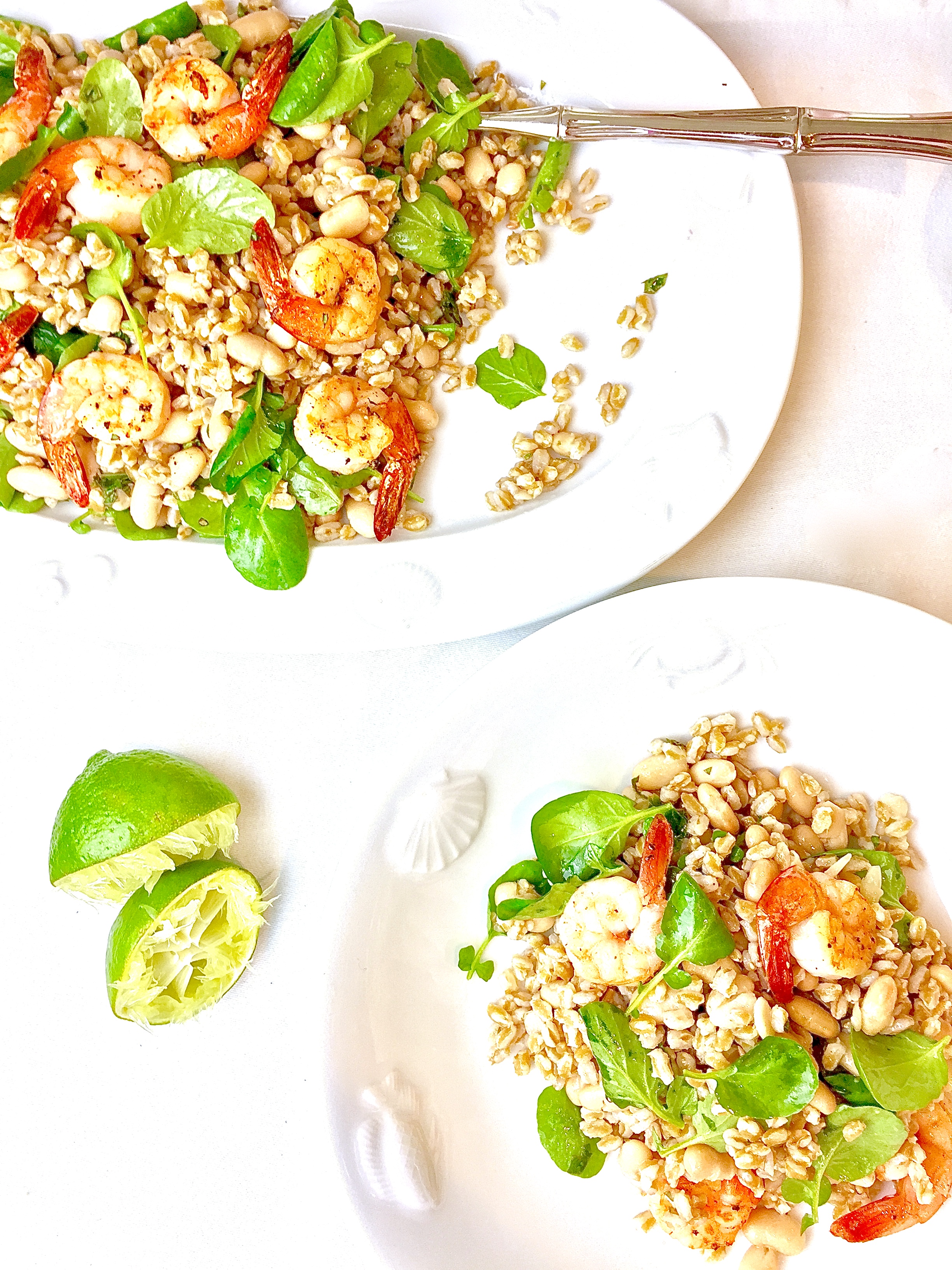 This wine is a beautiful crystalline pink color with a lovely bead and aromas of freshly baked popovers with strawberry butter. On the palate, flavors of red berries and pomegranate are accompanied by a bright acidity and dry finish. The sparkler nicely accentuates the flavor of the succulent pink shrimp and complements the spicy watercress, nutty farro and creamy white beans as well.I hope you find the time to enjoy this light, delicious dish before the Summer's over, and the pink sparkler certainly adds a special touch. If you've been spending time in the kitchen this Summer what has been your favorite dish to prepare? Do tell! Also, if you haven't had the chance, please stop by and "Like" the new Glamorous Gourmet & Wine Atelier Facebook Fan Page. I've recently revamped it and am having a lot of fun interacting with you fellow food and wine lovers. I'd greatly appreciate your support and hope you enjoy this dish as much as the Miskews do - Mangia!Cheers,
This wine is a beautiful crystalline pink color with a lovely bead and aromas of freshly baked popovers with strawberry butter. On the palate, flavors of red berries and pomegranate are accompanied by a bright acidity and dry finish. The sparkler nicely accentuates the flavor of the succulent pink shrimp and complements the spicy watercress, nutty farro and creamy white beans as well.I hope you find the time to enjoy this light, delicious dish before the Summer's over, and the pink sparkler certainly adds a special touch. If you've been spending time in the kitchen this Summer what has been your favorite dish to prepare? Do tell! Also, if you haven't had the chance, please stop by and "Like" the new Glamorous Gourmet & Wine Atelier Facebook Fan Page. I've recently revamped it and am having a lot of fun interacting with you fellow food and wine lovers. I'd greatly appreciate your support and hope you enjoy this dish as much as the Miskews do - Mangia!Cheers, "FAST + FABULOUS: ROASTED SHRIMP, WATERCRESS + FARRO SALAD"
Author:
Serves: 4-6 servings
Pair this dish with an Italian sparkling rosé like the Vigne Regali Cuvée Aurora for maximum deliciousness!
Ingredients
"FAST + FABULOUS: ROASTED SHRIMP, WATERCRESS + FARRO SALAD"
Author:
Serves: 4-6 servings
Pair this dish with an Italian sparkling rosé like the Vigne Regali Cuvée Aurora for maximum deliciousness!
Ingredients

With temperatures soaring into the high 90′s and above this Summer in South Florida, I’ve been craving dishes with delicious, lighter flavors as well as the delightful wines that pair with them.
The latest edition of “Fast & Fabulous” features Roasted Shrimp, Watercress and Farro Salad which definitely fits the bill. This dish has plenty of delicious flavor, great texture and healthy ingredients to boot. The recipe calls for farro, one of my favorite “ancient grains,” that Italians have been eating for over 2,000 years! This grain is also known as emmer or hulled wheat and was widely cultivated in the ancient world giving rise to the term “ancient grains” that today is used to refer to farro and other grains such as quinoa, amaranth and spelt, all of which have enjoyed a surge in popularity in recent years.
In addition to being tasty, farro also has health benefits including cholesterol-lowering fiber. A cup of farro has about 8 grams of fiber, while brown rice weighs in at around 5 grams. Whole grains like farro are also chock full of minerals such as magnesium which can help relieve tension and reduce the effects of stress. It’s complex carbohydrates also break down slowly, helping to keep your energy and blood sugar levels stable.
Given this dish’s Italian origins, what better than an Italian wine to pair with it? The Vigne Regali Cuvée Aurora Rosé 2008 ($29, click here to purchase) is a sparkling wine from Italy’s Piedmont region. It is made from 100% Pinot Noir grapes that were selected and hand picked in hilltop vineyards located in the Langhe in the south of Alba. This cuvée consists of 90% clear wine and 10% of the previous vintage wine, aged in French oak barriques. Fermentation takes place in the bottle the wine is later served from, as stipulated in the Methode Traditionelle, the same method used to make Champagne. This wine is a beautiful crystalline pink color with a lovely bead of bubbles and aromas of freshly baked popovers with strawberry butter. On the palate, flavors of red berries and pomegranate are accompanied by a bright acidity and dry finish. The sparkler nicely accentuates the flavor of the succulent pink shrimp and complements the spicy watercress, nutty farro and creamy white beans as well.
I hope you find the time to enjoy this light, delicious dish before the Summer’s over, and the pink sparkler certainly adds a special touch. If you’ve been spending time in the kitchen this Summer what has been your favorite dish to prepare? Do tell! Also, if you haven’t had the chance, please stop by and “Like” our new Glamorous Gourmet & Wine Atelier Facebook Fan Page. We recently revamped it and are having a lot of fun interacting with fellow food and wine lovers about pertinent food and wine topics. We’re also posting Daily Wine Reviews as well. We greatly appreciate your support – Mangia!
Cheers,
![]()

1 cup farro
1/2 cup extra virgin olive oil
1 1/2 lbs. shrimp, peeled and deveined
Juice of half a lime
2 Tablespoons chopped fresh mint leaves
Juice of 1/2 a lemon
1 15 oz. can of cannellini or Great Northern Beans, drained and rinsed
1 cup watercress leaves
Kosher Salt & Freshly Ground Black Pepper
Soak the farro in warm water for about 20 minutes. Drain and rinse well. Pour into a medium saucepan with enough water to cover by 1 inch. Cover the pot and bring to a boil, and then reduce to a simmer keeping the pot covered. Add a pinch of salt and cook for about 30-40 minutes, checking frequently. The farro should be soft but have a slight chew to it. Drain to remove excess water, and then transfer to a bowl and toss with 2 tablespoons of the olive oil. Set aside.
Preheat the broiler.
Toss the shrimp with 2 more tablespoons olive oil, some salt, pepper and the lime juice. Spread in an even layer on a baking sheet and broil for 10 minutes, flipping halfway through. Let cool slightly.
Make the salad dressing by combining the remaining 1/4 cup olive oil, mint, lemon juice and salt and pepper to taste in a small jar. Cover and shake vigorously to combine.
Toss together the farro, beans and watercress in a large bowl with half of the dressing. Season liberally with salt and pepper. To plate, transfer the salad to a large platter and top with the shrimp. Serve with the remaining dressing on the side. Makes 4 large or 6 small servings
"Oh, I can't drink red wine because of the sulfites, they give me a headache."
I often hear this statement at wine tastings and it represents one of the most commonly held misconceptions about "Red Wine Headache," a malady that affects many wine lovers. If you suffer from this affliction, there's some potentially surprising science behind the cause of these headaches as well as strategies you can employ to keep it from happening again in the future.
First, a little on sulfites: sulfur dioxide, or SO2, is the form of sulfur that's most relevant to winemaking. This chemical is actually more important for the preservation of white wine which has lower levels of natural preservatives than red wine. The primary function of sulfur dioxide is as a preservative and disinfectant yet it also inhibits bacteria and yeast as well. Sulfur dioxide preserves wine by reacting with oxygen, a well-known enemy of wine, to prevent oxidation which can adversely affect a wine's color and flavor. For this reason, it is also used, at much higher amounts than are found in wine, in many fruit juices and dried fruits to keep them from spoiling and turning brown.Tannins are chemical compounds which have important preservative properties which are derived primarily from grape skins and to a lesser extent from oak barrels. Red wine spends more time in contact with the grape skins and oak than white wine so it inherently contains more of these compounds. In the absence of tannins, higher levels of sulfites must be added to white wines to prevent spoilage. While it may come as a surprise that white wine contains more sulfites than red, sweet white wines generally contain even more sulfites than dry white wine! Higher levels of sulfites are needed in the sweeter wines to prevent any strains of wild yeast from inducing another fermentation because of the higher sugar content. So to sum it up, wines which contain the most sulfites in order of most to least are:1. Sweet White Wines (Sauternes, Juracon, etc)2. Dry White Wines (Sauvignon Blanc, Chardonnay, etc)3. Dry Red Wines (Cabernet Sauvignon, Pinot Noir, etc)The bottom line is, if you're experiencing headaches after consuming only red wine, sulfites are most likely not the culprit. Additionally, the most common reactions to sulfites are breathing-related problems (especially in asthmatics); sulfites are generally not known to cause headaches.So if it's not sulfites causing "Red Wine Headache" then what is it, you ask? Well the jury's still out on that one and, to date, there's no research that definitively answers that question. There are so many compounds in red wine (more than in white), it is difficult to pin the blame on just one. Some prime suspects, however, are the tyramines and histamines produced during malolactic fermentation which are present at much higher levels in red wine. These compounds are not unique to wine and are also present in food products that have been aged or fermented including cured meats, aged cheeses and soy.There are a few hypotheses as to why these chemicals can trigger these terrible headaches. One relates to the increase in serotonin levels caused by tyramines to which some individuals can be very sensitive. Just the mere fluctuation of these levels is enough to bring on a headache. Another explanation involves tyramines' ability to cause dilation and contraction of blood vessels which can also trigger a migraine. One researcher concluded that tyramines can actually induce headaches in up to 40% of migraine sufferers. Of course with all wine, white or red, there's the complicating factors of quantity of consumption and alcohol content which seem to exacerbate any existing sensitivity to the aforementioned chemical compounds making it even more difficult to identify the source.While there's no definitive answer as to the cause of "Red Wine Headache," there are some strategies you can employ to hopefully decrease your chance of experiencing it in the future. If you find yourself experiencing headaches after drinking red wine only it's probably best to stick to reds with lower levels of tannin and alcohol such as Pinot Noir and Gamay. Or, you might even embrace white wine more frequently which may reduce the incidence as well. Since we all have or own unique body chemistry it's best to learn through trial and error and let your body be your guide. Hopefully you can find a way to still enjoy the red wine you love while not having to suffer for it!Cheers,

“Oh, I can’t drink red wine because of the sulfites, they give me a headache.”
I often hear this statement at wine tastings and it represents one of the most commonly held misconceptions about “Red Wine Headache,” a malady that affects many wine lovers. If you suffer from this affliction, there’s some potentially surprising science behind the cause of these headaches as well as strategies you can employ to keep it from happening again in the future.
First, a little on sulfites: sulfur dioxide, or SO2, is the form of sulfur that’s most relevant to winemaking. This chemical is actually more important for the preservation of white wine which has lower levels of natural preservatives than red wine. The primary function of sulfur dioxide is as a preservative and disinfectant yet it also inhibits bacteria and yeast as well. Sulfur dioxide preserves wine by reacting with oxygen, a well-known enemy of wine, to prevent oxidation which can adversely affect a wine’s color and flavor. For this reason, it is also used, at much higher amounts than are found in wine, in many fruit juices and dried fruits to keep them from spoiling and turning brown.
Tannins are chemical compounds which have important preservative properties which are derived primarily from grape skins and to a lesser extent from oak barrels. Red wine spends more time in contact with the grape skins and oak than white wine so it inherently contains more of these compounds. In the absence of tannins, higher levels of sulfites must be added to white wines to prevent spoilage. While it may come as a surprise that white wine contains more sulfites than red, sweet white wines generally contain even more sulfites than dry white wine! Higher levels of sulfites are needed in the sweeter wines to prevent any strains of wild yeast from inducing another fermentation because of the higher sugar content. So to sum it up, wines which contain the most sulfites in order of most to least are:
1. Sweet White Wines (Sauternes, Juracon, etc)
2. Dry White Wines (Sauvignon Blanc, Chardonnay, etc)
3. Dry Red Wines (Cabernet Sauvignon, Pinot Noir, etc)
The bottom line is, if you’re experiencing headaches after consuming only red wine, sulfites are most likely not the culprit. Additionally, the most common reactions to sulfites are breathing-related problems (especially in asthmatics); sulfites are generally not known to cause headaches.
So if it’s not sulfites causing “Red Wine Headache” then what is it, you ask? Well the jury’s still out on that one and, to date, there’s no research that definitively answers that question. There are so many compounds in red wine (more than in white), it is difficult to pin the blame on just one. Some prime suspects, however, are the tyramines and histamines produced during malolactic fermentation which are present at much higher levels in red wine. These compounds are not unique to wine and are also present in food products that have been aged or fermented including cured meats, aged cheeses and soy.
There are a few hypotheses as to why these chemicals can trigger these terrible headaches. One relates to the increase in serotonin levels caused by tyramines to which some individuals can be very sensitive. Just the mere fluctuation of these levels is enough to bring on a headache. Another explanation involves tyramines’ ability to cause dilation and contraction of blood vessels which can also trigger a migraine. One researcher concluded that tyramines can actually induce headaches in up to 40% of migraine sufferers. Of course with all wine, white or red, there’s the complicating factors of quantity of consumption and alcohol content which seem to exacerbate any existing sensitivity to the aforementioned chemical compounds making it even more difficult to identify the source.
While there’s no definitive answer as to the cause of “Red Wine Headache,” there are some strategies you can employ to hopefully decrease your chance of experiencing it in the future. If you find yourself experiencing headaches after drinking red wine only it’s probably best to stick to reds with lower levels of tannin and alcohol such as Pinot Noir and Gamay. Or, you might even embrace white wine more frequently which may reduce the incidence as well. Since we all have or own unique body chemistry it’s best to learn through trial and error and let your body be your guide. Hopefully you can find a way to still enjoy the red wine you love while not having to suffer for it!
Cheers,
![]()